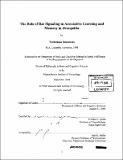| dc.contributor.advisor | William G. Quinn. | en_US |
| dc.contributor.author | Sakamoto, Toshimasa | en_US |
| dc.contributor.other | Massachusetts Institute of Technology. Dept. of Brain and Cognitive Sciences. | en_US |
| dc.date.accessioned | 2006-11-07T12:28:21Z | |
| dc.date.available | 2006-11-07T12:28:21Z | |
| dc.date.copyright | 2004 | en_US |
| dc.date.issued | 2004 | en_US |
| dc.identifier.uri | http://hdl.handle.net/1721.1/34483 | |
| dc.description | Thesis (Ph. D.)--Massachusetts Institute of Technology, Dept. of Brain and Cognitive Sciences, 2004. | en_US |
| dc.description | Includes bibliographical references. | en_US |
| dc.description.abstract | Ras is an evolutionally conserved signaling molecule that has been implicated in a variety of cellular events, such as cell proliferation, differentiation, and survival. Recent studies also suggest roles of Ras in neuronal plasticity. I investigated the role of Ras in associative learning and memory in Drosophila. Flies carrying hypomorphic ras mutations were impaired in memory, with normal learning performance. The severity of the memory impairment correlated with molecular lesions in the ras gene. Studies on synaptic morphology at larval neuromuscular junctions revealed an increased number of presynaptic varicosities in the ras mutants. Flies carrying a dominant-negative or -active form of a ras transgene showed a learning impairment, when expression of the transgene occurred in the mushroom bodies (MBs), the center for the associative learning and memory. Acute induction of dominant-active ras expression also resulted in a learning impairment. Simple sensorimotor functions and overall MB morphology were normal in all the flies that showed learning or memory impairments. These results collectively suggest a direct role of Ras signaling in associative learning and memory in Drosophila. | en_US |
| dc.description.abstract | (cont.) Here, I also present the results of characterization of a strong eye phenotype resulting from inhibition of Ras signaling. When a dominant-negative form of mammalian ras was expressed in the eye imaginal disc, flies developed eyes that are severely reduced in size. The phenotype was modified in a way sensitive to the level of Ras signaling. It was based on massive cell death resulting from inhibition of EGFR/Ras-dependent signaling pathways, including the MAPK and PI3-K pathways. Additional components such as Amnesiac and Rap appeared to modulate the signaling machinery associated with the phenotype. Oncogenic ras has been implicated in many types of tumors. This Ras-associated small eye phenotype may provide a new powerful tool to help develop therapeutic strategies for human cancers, as well as further understand the complexity of Ras signaling in basic biological events. | en_US |
| dc.description.statementofresponsibility | by Toshimasa Sakamoto. | en_US |
| dc.format.extent | 145 p. | en_US |
| dc.format.extent | 28138036 bytes | |
| dc.format.extent | 28137827 bytes | |
| dc.format.mimetype | application/pdf | |
| dc.format.mimetype | application/pdf | |
| dc.language.iso | eng | en_US |
| dc.publisher | Massachusetts Institute of Technology | en_US |
| dc.rights | M.I.T. theses are protected by copyright. They may be viewed from this source for any purpose, but reproduction or distribution in any format is prohibited without written permission. See provided URL for inquiries about permission. | en_US |
| dc.rights.uri | http://dspace.mit.edu/handle/1721.1/7582 | |
| dc.subject | Brain and Cognitive Sciences. | en_US |
| dc.title | The role of ras signaling associative learning and memory in Drosophila | en_US |
| dc.type | Thesis | en_US |
| dc.description.degree | Ph.D. | en_US |
| dc.contributor.department | Massachusetts Institute of Technology. Department of Brain and Cognitive Sciences | |
| dc.identifier.oclc | 70785732 | en_US |
